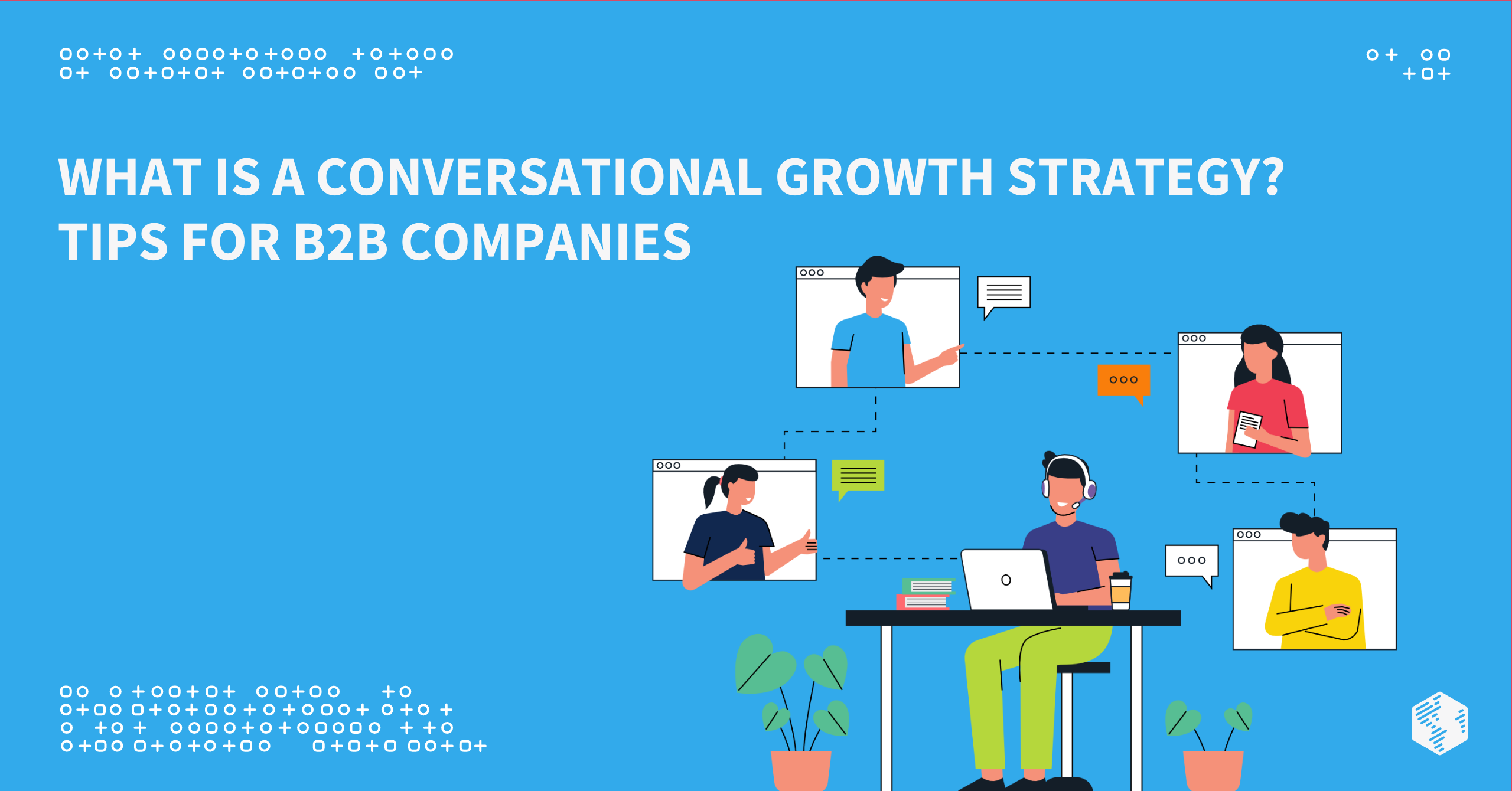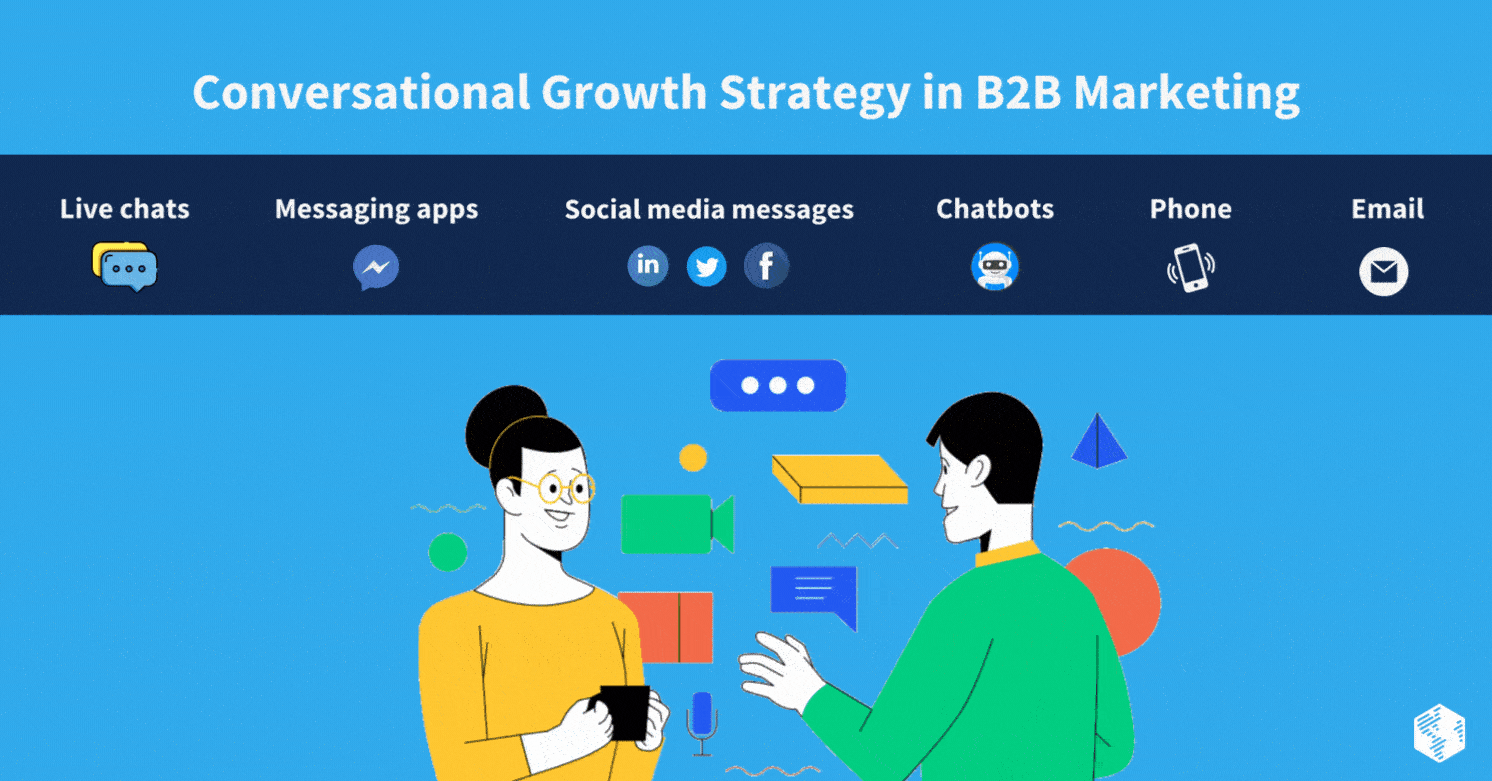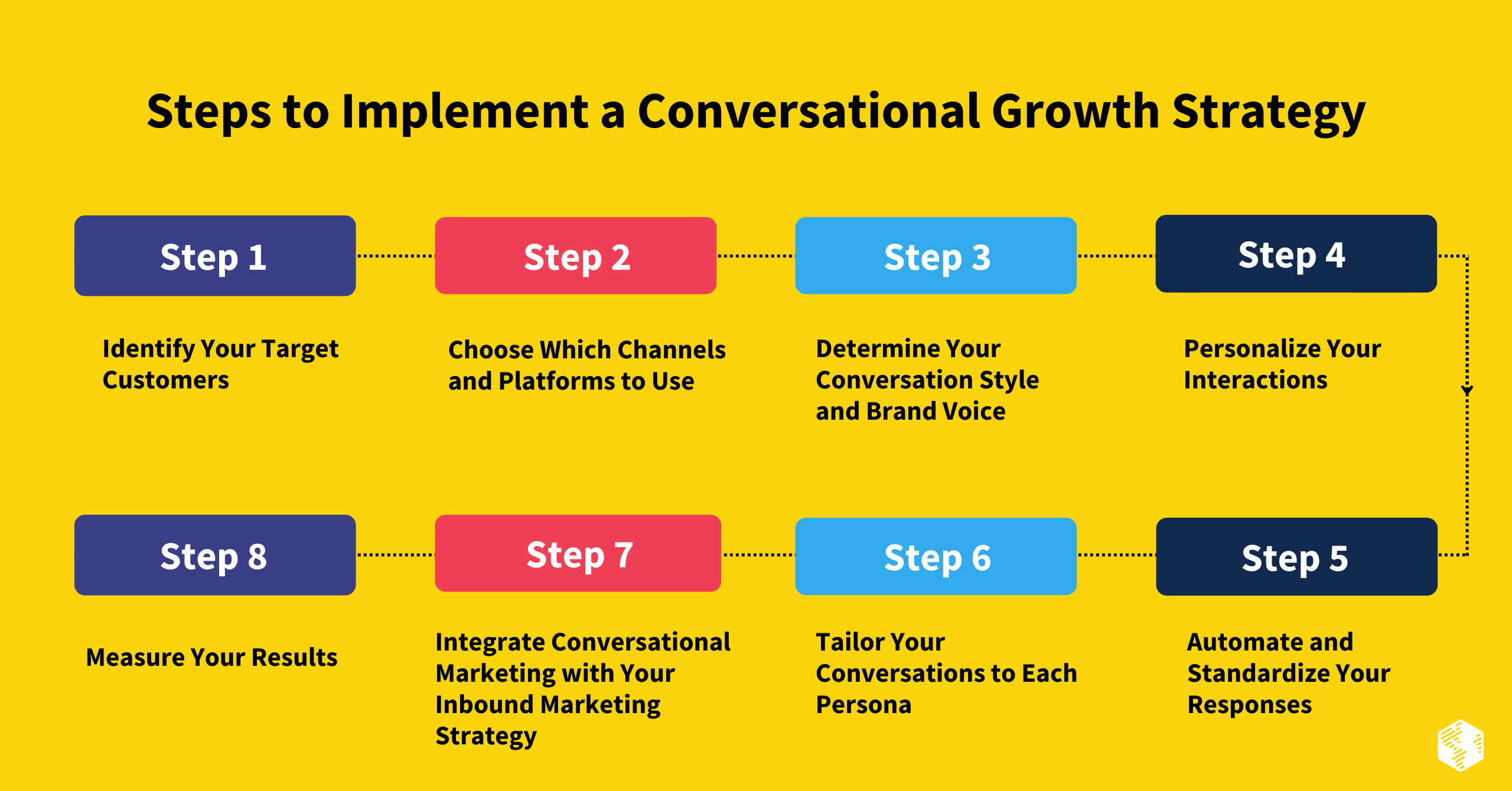Business-to-business (B2B) marketing is always evolving, and to beat the competition, you have to be prepared to adapt to new marketing terrains.
Conversations have forever been one of the best ways to build relationships with customers, but the old ways of doing business aren’t cutting it anymore. One-way methods of communication like emails and forms for visitors to fill out on your website aren’t enough to keep the attention of prospects anymore. Instead, you need to meaningfully interact with buyers before you can convert them into customers.
This new way of approaching your marketing—where communication is a two-way street and engagement comes from one-on-one conversations—is key to convincing a buyer that your solution or service is right for their company.
Let’s take a closer look at conversational marketing.
What Is a Conversational Growth Strategy in B2B Marketing?
Conversational marketing is an updated approach to interacting with customers. This type of marketing is built on the power of conversations—with customers, via different channels, and implemented across various platforms.
Any type of two-way conversation, where customers have the chance to communicate with your business, can be a useful part of conversational marketing:
- Live chats
- Messaging apps
- Social media messages
- Chatbots
- Phone
But conversational marketing isn’t about which tools you use; instead, it’s about establishing and maintaining a dialogue with buyers, offering instant responses, and meeting customers where they are already spending their time.
With new marketing technology, B2B companies can automate and optimize these conversations, guide leads through your sales funnel, and make interactions with customers seamless. Thanks to chatbots, live chats, and other automation tools, conversational marketing allows you to build meaningful relationships with customers at a massive scale and then use those conversations to grow your business.
Why Are Conversations Important in an Inbound Marketing Strategy?
The base of conversational marketing is, of course, conversations.
While the old way of doing business may have meant making cold calls, knocking on doors, or sending emails, the new way to approaching customer relationships is by making it easy for buyers to start the conversation with you. Your job, then, is to meet them where they are and keep that conversation going.
Here’s why you can’t ignore the benefits of having one-on-one interactions with buyers.
Conversations Are Natural and Easy
Just about everyone on the planet has had a conversation with someone else—probably today. It’s human nature.
They are easy to start, too; it’s as simple as offering a greeting and introduction. Sure, some people may ignore you, but that’s okay, because some people will respond, and then the conversation begins.
Conversations Are Convenient
Conversational marketing happens whenever the customer prefers, whether through instant responses via a chatbot or a live chat where you and the customer converse on and off throughout the day.
These conversations should also happen on the channel that best suits your customers. With so many options, it will take some strategic planning to find which method is right for your business.
Conversations Are an Opportunity to Gather Information
In face-to-face conversations, how often do you casually exchange information with your conversation partner? If you don’t know someone’s name, for example, you introduce yourself and they, in turn, share theirs. We are constantly sharing parts of our personal lives without a second thought.
Conversational marketing is similar in that it lets you gather information and gain new insights about your customers. It’s an opportunity for them to share with you about what they want to do or what problem they need to solve—and with conversational marketing, you can collect large amounts of that valuable data.
Conversations Are a Great Way to Build Relationships
At the end of the day, conversations are how you build one-on-one relationships with your prospects and customers. And this natural exchange of thoughts, feelings, and ideas—one conversation at a time—can happen at scale with marketing automation tools like chatbots.
What Are the Steps to Implementing a Conversational Growth Strategy?
To implement an effective conversational growth strategy, you need to consider how it fits into your overall inbound marketing strategy, which channels and tools make the most sense for your team and customers, and what approach you want to take to create meaningful conversations with prospects.
1. Identify Your Target Customers
Buyer personas are a critically important part of any marketing strategy. By identifying your target customers and learning more about their wants and needs, you can have conversations and create experiences that cater directly to different prospect groups. These personas will guide every other step in your conversational growth strategy.
2. Choose Which Channels and Platforms to Use
After identifying your target customers, ask yourself these questions:
- Where do your customers spend time online?
- How do your prospects like to communicate?
- What communication channels do your customers use?
There are a variety of channels you can use to engage in one-on-one conversations with your prospective customers. Narrowing that list to a few channels will make it easy to determine where to focus your marketing efforts.
Additionally, consider the limits of your platform and content management system (CMS). Some applications, like certain chatbots and live chats, may not be able to easily integrate with your existing technology, so be sure to check whether the channels and platforms you consider are compatible.
3. Determine Your Conversation Style and Brand Voice
Your company’s brand—especially its tone, voice, and personality—will guide your conversations with customers. Is your brand casual and funny or professional and direct? Does your conversation style change depending on who you are communicating with? Decide what tone you want to set in your conversations with customers.
Another thing to keep in mind is that buyers want to communicate with humans, so making chatbots as human as possible will encourage customers to engage more.
4. Personalize Your Interactions
When speaking with a customer—whether through messaging apps, live chats, chatbots, or other communication systems—include personalized details to make the conversation feel more natural. Simply addressing the customer by name and answering their questions makes them feel like they are being heard and seen.
5. Automate and Standardize Your Responses
At the same time, it’s important not to get too caught up in personalizing your conversations. While slightly customizing messages for each customer is a good way of building a relationship, standardizing elements of conversations not only streamlines your marketing process but also ensures you have consistent answers across platforms.
A good way to get started is to figure out the FAQs or common issues your customers bring up in conversations and then draft approved answers and solutions. Your marketing and sales team as well as your chatbots will know exactly what to say.
Marking automation platforms with conversational integrations make this process even easier. By having chatbots greet new website visitors, automation frees up your sales team to focus on qualified leads.
6. Tailor Your Conversations to Each Persona
Marketing to your targeted customers requires a combination of personalization and standardization. In other words, create personalized conversations unique to each persona group and standardize responses in those categories.
For example, buyers who found their way to your website via a social media advertisement are likely looking for educational experiences or answers to FAQs, so there’s no need to involve sales quite yet. Instead, you can focus on pointing them to areas of your website with links to relevant resources.
On the other hand, customers landing on your pricing page are much more likely to make a purchasing decision, so you may want to program your chatbot to start conversations with specific calls to action (CTAs).
7. Integrate Conversational Marketing with Your Overall Inbound Marketing Strategy
Conversational growth marketing does not exist in a vacuum. Instead, you need to integrate it into your overall inbound marketing strategy.
Since conversational marketing reaches across various channels, you can use it to amplify your social media, blog posts, landing pages, etc. Integrate conversational marketing into your social media and email marketing to take advantage of the data gathered by live chats, chatbots, messaging apps, and other conversational elements.
READ: Hiring an Inbound Marketing Agency: Everything You Need to Know
8. Measure Your Results
What does successful conversational growth marketing look like?
There are several metrics you could use to measure the results of a marketing campaign, including your website conversion rate as well as your revenue. No matter how you define success, take a baseline measurement before introducing a new conversational growth campaign so you can determine your return on investment (ROI).
Based on your results, you can tweak your conversational marketing strategy until you find the right combination of platforms and conversation style to build effective, natural relationships with your targeted customer base.
What Role Does Optimization Play in Your Conversational Growth Strategy?
Optimization plays an essential role in your conversational growth marketing strategy. By analyzing the success and results of past campaigns, you can improve them in the future. Additionally, after collecting data from the different platforms you are using, you can get a better picture of the buyer experience and figure out how to play to the strengths of each channel.
Conversations should be optimized, as well. Refresh the copy of your chatbots and standardized live chat responses over time to keep up with any updates in your business as well as keep conversations authentic.
Just like any other marketing campaign, you need to iterate and optimize your conversational growth strategy over time, making changes based on data and continuing to increase conversions.
How Can B2B Companies Create a HubSpot Conversational Growth Strategy?
With a conversational growth marketing strategy, you can obtain more leads, increase revenue, and grow your business, but actually putting a plan into action is a different story. Fortunately, there are software solutions on the market built to help you implement conversational marketing as part of your larger inbound marking efforts.
Our favorite inbound marketing tool? HubSpot.
HubSpot’s live chat and automated chatbot software is the best on the market for engaging with visitors to your website in real-time. It’s the first step to building relationships with prospects and converting them into lifelong customers.
At OneIMS, we use HubSpot to help drive traffic to our clients’ websites and turn their leads into customers—and we can do the same for you because we have the knowledge and strategies needed to make HubSpot’s tools work as effectively and efficiently as possible.
Together, we can take advantage of HubSpot’s inbound marketing software to create a conversational growth strategy that nurtures relationships, improves metrics, and turns your happy customers into ambassadors for your brand.
Conclusion
Are you ready to benefit from conversational growth marketing? We can help.
With more than 16 years of digital marketing experience, we have seen how conversational marketing helps businesses grow, and we know exactly how to implement it.
The marketing experts at OneIMS have the solutions, strategies, and tools you need to reach and engage your prospects and buyers—turning them into repeat customers and helping you grow your client base. We serve B2B companies in a variety of industries and are ready to build a strong conversational marketing strategy for your business.
But you don’t have to take our word for it. View case studies from some of our happy customers and read our blog to get an idea of our training and experience.
Interested in learning more about our conversational marketing solutions? Check out our process or schedule a consultation with us today.



































